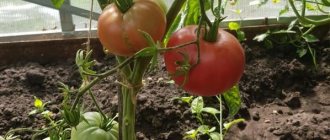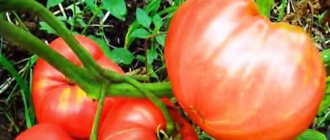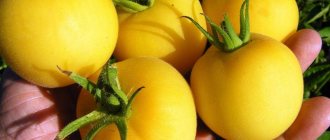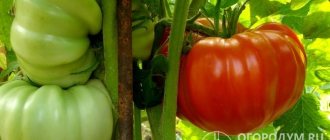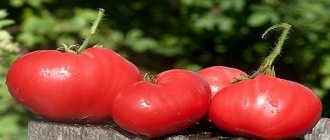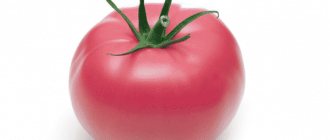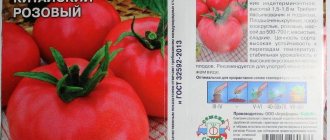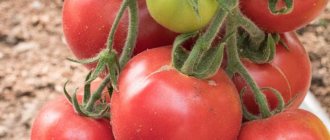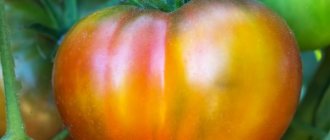Pink-fruited tomatoes are favorites in every garden and farmstead. Mikado pink stands out in the group. Giant tomatoes, delicious taste, easy cultivation - these are some of its main bonuses.
| Height | Landing location | Ripening time | Fruit color | Fruit size | Origin | Fruit shape |
| Tall | Greenhouse, Open ground | Late ripening | Pink | Large | Variety | Flat-round |
Description of large fruits and yield
In the southern regions, Mikado is grown in open ground, but in the middle zone, and even more so in the north, it is better to use greenhouses.
It takes a little more than two months to grow high-quality seedlings; the timing of sowing seeds in cups is calculated taking into account this situation and the climate of the region. Caring for seedlings is no different from that for other varieties; Hardening off the seedlings a week before planting in the garden is mandatory. Mikado prefers light soils and does not tolerate partial shade: to obtain high-sugar fruits, they try to plant it in a well-lit place. Two or three plants are planted per square meter of bed. Stakes up to two meters high are driven in immediately; the bushes have to be tied up even before the fruits form.
Mikado is watered abundantly, at the root, but from the moment the tomatoes begin to ripen, the intensity of watering is reduced. Fertilizing is applied 3-4 times per season: in the first half of summer they prefer to feed with infusions of organic matter, in the second half they limit themselves to infusions of wood ash.
Bushes are most often formed into two stems. Stepchildren must be removed systematically, when they reach a size of 4–5 cm. After the formation of the first flower cluster, all the leaves located below it from Mikado are usually torn off. This is done in sunny weather using sharp scissors. Subsequently, those leaves that cover the ripening fruits from the sun are removed. The tops of the shoots are pinched at the beginning of August.
One of the strongest lower stepsons is used as the second stem.
The most delicious fruits are those ripened on the bushes. Since Mikado does not produce many tomatoes, and their ripening time is relatively early, there is no point in picking unripe fruits.
Like any variety, “Mikado Pink” has its own characteristics in caring for the plant. Let's look at the main nuances of how to properly grow tomatoes.
First of all, the seeds need to be sorted so that only high-quality seeds are used for sowing. To do this, take a glass of warm water, add a teaspoon of salt to it and pour in the seeds, leaving them in the liquid for 20 minutes. Empty and diseased seeds will float, but good ones will remain at the bottom.
You can then disinfect the seeds, for example, by soaking them in a 1% manganese solution.
After this, the gauze is placed in a shallow container and water is added. Tomato seeds are placed on top until they sprout.
ATTENTION: It is important to ensure that the liquid in the container does not evaporate.
There is nothing complicated about sowing prepared seeds. You need to take a shallow but long pot with soil. Plant the seeds to a depth of no more than 1 cm. Cover the pot with film and place in a well-lit place.
First you need to make holes and immediately insert high vertical supports into them for future bushes. The distance between the bushes, so that they do not interfere with each other, should be at least 50 cm long and 40 cm wide between rows.
IMPORTANT: To grow tomatoes, you must choose an area with good lighting.
The yield, even if agricultural technology is followed, is relatively not very high. An average of 8-10 fruits ripen on one bush. From one square meter you can collect about 6 kg.
The variety does not tolerate cold and temperature changes well, so it is best to grow it in open ground only in the southern regions. In temperate regions, it is recommended to grow the Mikado pink tomato in a greenhouse.
Productivity is not one of the variety's strengths. From one large bush it is possible to remove up to 5 kilograms of tomatoes, and in particularly favorable conditions - up to 7 kilograms.
To get an early harvest, seedlings are sown at the end of February. In this case, most likely, the seedlings will have to be illuminated. The optimal temperature for their development is about 22 degrees. After picking and hardening, when the threat of frost has passed, the seedlings are placed in a permanent place.
If the seedlings have stretched out, they can be buried by placing them obliquely, with their tops facing north. Planting is immediately carried out near trellises or single strong supports that can be driven into the hole. Then, as they grow, stems are attached to them, and when they are filled, brushes are attached. The best soils are loamy or sandy loam, but even on them the bushes will have to be fertilized regularly.
From 1 m2 they harvest 8-10 kg, the yield of 1 bush varies from 4 to 6 kg.
The seedlings are transplanted to a permanent place at the age of 50-55 days.
The bushes are no denser than 3-4 plants per 1 m2. The optimal depth of the hole is 30 cm. The following fertilizers are added to it:
- a handful of compost;
- 10 g of phosphorus-potassium mixture;
- 1 tbsp. wood ash.
What features should be observed when caring for tomatoes:
- feeding during flowering and ripening, watering with mullein solutions, bio-infusions, mineral composition;
- mulching with straw, hay in a layer of at least 8 cm;
- pinching once every 10 days, tying to trellises.
Mid-season / Tall
User rating: 5/5
Late ripening / Tall
User rating: 5/5
Mid-season / Tall
The Mikado pink variety is a delicious large and sweet pink tomato. After harvesting a good harvest, it is recommended to process the tomatoes. The variety is not suitable for whole-fruit canning; it changes its taste when pickled. It exhibits its best taste when fresh.
Harvest of Mikado pink tomatoes
Planting seedlings in a permanent place
When 60 days have passed since sowing the seeds, and when the air and soil have warmed up to consistently optimal temperatures, you can begin planting seedlings in open ground. Depending on the geographic location, this occurs most often from mid-May to early June.
Since tomatoes of the “Mikado pink” variety have increased demands on lighting, the beds for them, which are prepared in the fall, must be located in elevated places, maximally illuminated by the sun, but protected from the influence of strong winds. Tomatoes respond very well to the soil on which the following crops were previously cultivated:
- beet;
- cucumbers;
- cabbage;
- carrot;
- onion;
- legumes
But you should absolutely not plant tomatoes in areas that were previously planted:
- potatoes;
- tomatoes;
- eggplants;
- tobacco;
- pepper
Usually, when planting Mikado pink tomato seedlings, a maximum of 3 bushes are placed per 1 square meter. The wells are disinfected with a low-percentage manganese solution and fertilized with two tablespoons of phosphorus and potassium fertilizers.
Important! The lack of sunlight has a noticeable effect -
the number of ovaries on the plant decreases .
The depth of the holes is selected in such a way that when the root ball of the seedlings is filled in, the soil level reaches the cotyledon leaves. Immediately after planting the seedlings, it must be watered with heated, but not hot, water.
Origin of the tomato variety "Mikado Pink"
There is no reliable information about the exact origin of this variety. Some claim that it originated from the ShahMikado variety, common in America, while others suggest that it was bred on Sakhalin under the USSR.
We suggest you familiarize yourself with: The best varieties of tomatoes for pickling and canning
Let’s start with it because this variety has passed state tests, which means it has confirmed characteristics. The creation of a pink-fruited species was announced in 2013 by Gavrish Breeding Company LLC. It was included in the State Register in 2015 with admission to all regions of the country. Recommended for film greenhouses on private farms.
Bush care
Fertilizing is combined with watering using saltpeter, potassium salts and superphosphate. It is convenient to apply complex fertilizers that contain microelements necessary for full fruiting.
The variety is quite capricious and requires constant thorough care.
You need to weed and loosen the soil, just like for other tomatoes. Water at the root, in the evening with heated water so that it does not fall on the above-ground part, but goes straight to the roots. Pruning must be carried out so that unnecessary shoots do not thicken the planting. This is done weekly throughout the growing season until they grow more than 5 centimeters.
The Mikado tomato is characterized by very tasty fruits, but other characteristics of the variety are far from ideal. It is popular among gardeners, but they plant it a little: so that you can enjoy delicious tomatoes without taking up unnecessary space in the beds.
The bushes of this variety are quite capricious and require special attention:
- Hilling. A few days after planting, the bushes need to be hilled;
- Watering. The bushes need to be watered not very often, but abundantly. Plants should not be overwatered to prevent the roots from rotting;
- Weeding. It is necessary to regularly remove weeds so that they do not take nutrients from the tomatoes;
- Loosening the soil;
- Feeding. The first fertilizer is applied a week after planting the seedlings, and the second - after 14 days.
IMPORTANT: It is necessary to remove the lower leaves of the bush as it grows upward so that the plant does not waste its energy on their growth, instead of directing all the nutrients to the leaves.
The general opinion of gardeners about this variety is that this tomato is not easy to care for, and the bushes are very capricious and are also too susceptible to various fungal diseases. Inexperienced gardeners' bushes may even die. The fruits are sweet and tasty and very juicy, but the harvest is not large.
For those who want to get a harvest of delicious pink and large tomatoes and at the same time have little experience in growing tomatoes, “Mikado Pink” is perfect. For those who don’t want to go to the trouble of caring for bushes, this variety may not be suitable.
Planting seedlings in heated greenhouses can occur at the very beginning of April, in cold regions of the country. For unheated greenhouses, sowing seeds can begin in early March, then in May we will receive seedlings suitable for planting.
Approximately 2 months before planting in a permanent place, you need to prepare containers with soil and seeds. Drainage in the form of coarse sand is poured onto the bottom of the containers. The soil is prepared from ordinary garden soil, but it is pre-roasted. Fine sand, rotted mullein and ash are added to the soil. Wet soil should not stick together when compressed, but have a crumbly structure.
During the two months that the seedlings will spend in containers, they need to be fed and fertilized three times. You can dive at the stage of appearance of two pairs of true leaves. Fertilizing is carried out with liquid organic matter. To do this, take mullein in a 1:2 ratio and place it in a warm place for two weeks. The finished mixture is diluted with warm water 1:10 and watered very carefully, at the root.
Boric acid can be used to fertilize and control small insects. It is also diluted with water, but different manufacturers produce it in different concentrations. Therefore, you should prepare the required solution by following the instructions. Foliar feeding is carried out by spraying. Tomatoes respond very well to fertilizer, and the seedlings grow strong and healthy.
Before planting seedlings in the ground, they must be hardened off for 10 days. To do this, the containers are taken out into the fresh air under the sun, starting from 30 minutes a day. By gradually increasing this term, we will be able to harden our seedlings and they will not get burned when transplanted into open ground. But, since our Mikado Pink tomatoes are mostly grown in greenhouses, there is no need to harden the plants.
The characteristics of this variety suggest that in greenhouse conditions they grow more productive and more resistant to disease. Tomatoes are removed from containers and transferred to greenhouses. Before this, mark the future rows so that for 1 square. m there were no more than 4 plants, and the aisles between the rows are not taken into account. The holes are filled with a hoe, and a strong support is installed near each of them.
This variety will bear fruit better in greenhouse conditions.
Ash and manure that has been rotted for several years can be poured into the holes. Each hole is spilled with warm water and tomatoes are planted. The room temperature is maintained at the same temperature, about 25 degrees, and the plants are watered abundantly because they love moist soil.
Caring for tomatoes is not very difficult, you just need to follow some rules.
- Be sure to tie up the stems and the area of the fruit cluster.
- Remove all stepsons except the first, from which the second stem is formed.
- It is advisable to remove excess leaves for better air circulation.
- Constantly loosen the soil and remove weeds, which can be used as organic fertilizer.
- Water only with warm water in the evening or in cloudy weather.
- Carry out the necessary fertilizing for better growth and ripening of fruits.
- Carry out preventive treatment of bushes to prevent the development of viruses and diseases.
We suggest you familiarize yourself with: Varieties of tomatoes with striped color
Heavy Mikado fruits can cause stem breakage, so securing them to supports will be necessary.
After the formation of the second stem, in order to prevent the plant from weakening, all newly formed stepsons are removed. They and weeds that have not had time to set seeds can be used as organic fertilizers. To do this, put all the greens in a barrel or other container and fill it with water. After some time, the fermented mixture is diluted with water 1:10 and watered under the root.
Chemical fertilizers can also be used when preparing solutions for foliar feeding. A description of the operation and recipe is usually found on the back of the package. A drug such as boric acid and its derivatives can be used as an insect repellent.
Growing rules
Mikado is suitable for cultivation even in northern regions. Greenhouses and greenhouses are used for this. In the southern regions, the plant tolerates the use of open ground well.
Planting seedlings
Seedlings must be grown within 60-85 days. Ideal seedlings should reach 10-15 cm in height, have true leaves and inflorescences. Poorly developed bushes are difficult to adapt and are more often affected by various diseases.
Tomato seeds are planted in any available containers - pots, wooden and plastic boxes, special cassettes for seedlings. You can purchase ready-made soil or make it yourself. To do this, mix the following components:
- Peat – 6-7 parts.
- Sod land - 1 part.
- Sawdust – 0.5 parts.
Picking of sprouts is carried out at the stage of formation of 2 full leaves.
Tomato transplant
A cloudy day is chosen for transplanting seedlings. You can disembark in the evening. This way the plant will take root better and faster. The holes for tomatoes are made deep and wide enough. An additional support in the form of a stick is placed in each hole, since the bushes grow quite tall.
Organic fertilizers (compost, humus), as well as wood ash and phosphorus are added to the soil. The soil is thoroughly loosened and moistened. Young bushes are planted 2-3 pieces per 1 square meter. m. Water depending on weather conditions several times a week.
Subsequent care for tomatoes
A few days after planting, the bushes need to be hilled up and the soil next to them loosened. It is advisable to water tomatoes several times a week, taking into account weather conditions. Remove weeds from the garden bed in a timely manner.
To get a good harvest, cut off the lower leaves of the plant and remove the sprouts. In addition, preventive measures are taken to prevent the occurrence of diseases.
Advice! Tomatoes of this variety are very demanding on soil. Therefore, it is necessary to apply complex fertilizers that will enrich the soil with oxygen.
Agricultural technology
It is recommended to grow the variety in seedlings, regardless of region. Sowing of seedlings is carried out 55 - 60 days before the intended transplantation into the ground. Picking - at the stage of 2 true leaves. Indent Mikado pink requires a mandatory garter to a support or trellis. In cool regions, the plant is formed into 1 or 2 stems.
In the middle or end of August, the stem is pinched above the upper fruit cluster, leaving 2 leaves above it. Removing the lower leaves under the ripe fruit cluster and pinching accelerates the ripening of the remaining tomatoes. In the southern regions, the plant is often formed into 3 or 4 stems. Planting density is 3 bushes per 1 square meter; when formed into 1 stem, up to 4 plants can be compacted.
The pink-fruited variety is valued for its excellent taste and presentation of ripe fruits. This crop is for those gourmets who appreciate the sugary taste and fleshy pulp, but are not chasing a record harvest. The big plus is that, if desired, you can collect the seeds yourself.
Seedlings begin to be sown in the second half of March, adhering to the gardener's lunar sowing calendar. You can always buy soil in most stores; during the season, they sell soil for seedlings of flowers and crops at various retail outlets that are not even related to gardening. This soil has an optimally balanced composition; you do not need to add any additional fertilizer while the seedlings grow in it.
If you want to use your soil, it should be garden soil, humus and sand. You also add a spoonful of superphosphate here, pour boiling water over it in advance to remove parasites, and also add a handful of ash. You can pour this soil into separate pots or into a common container. Don't forget that there should be holes in the containers for drainage. Now we move on to pre-sowing treatment.
First you need to select the seeds for germination; this is done simply with the help of water. Seeds that have not sunk are empty and do not need to be planted. To make the crops germinate better and for additional immunity, you can soak the seed material in aloe juice. Then the seeds are sown to a depth of 1.5 cm at a distance of 2-3 cm from each other, this is if the container is shared.
Transfer to the greenhouse will be from the beginning of May, to the street in the third decade of the month or in June. The soil is prepared in advance and the supports too. Planting should be done 50/50 cm. A high, strong support is immediately placed in the hole. Mikado tomatoes love light, so choose the sunniest area. If the summer turns out to be cloudy, then lamps will be needed.
Characteristics
The variety is early ripening: already 90-95 days after the appearance of the first shoots, gardeners try the first Mikado tomatoes. But you cannot call all members of the family early-ripening: yellow and red ones ripen later - by August.
The main advantages of the plant
The Mikado series feels better in the European and southern parts of the country. The closer to the Urals and further east from it, the less often you will find tomatoes of this variety. But Siberian breeders filled the gap by offering gardeners from the risky farming zone the zoned “Mikado Sibiriko”.
We offer a description of the main parameters characteristic of all varieties of the variety:
- The bush is tall, indeterminate, the height is up to 1.9 -2 meters and above. In the greenhouse, the tops are pinched to limit growth. Black tomatoes stand out from the series: compact plants do not exceed 1.5-1.6 m.
- Representatives of the imperial tomato clan are distinguished by their potato leaves.
- Maximum yield when planting no more than 3 roots per meter of area and growing in 1-2 shoots.
- The first cluster is usually tied above the 8-9th leaf, the rest after two leaves. The variety requires the obligatory formation of a bush, garter, and pinching.
- You can’t call a “mikado” an unpretentious plant: it requires constant attention, feeding, and is sensitive to watering.
- The average yield is 7-8-9 kg per bush per season. Depends on the weather and care.
- Susceptible to late blight. In greenhouses and hotbeds it is easier to avoid problems, and in open ground the health of tomato beds is taken extra care of.
How and where to plant these tomatoes depends on desire, time, and experience. But without taking into account the recommendations of agricultural technicians, a gardener is unlikely to join the army of fans of a variety with excellent data.
Variety Mikado Sibiriko
This is a real Siberian. Siberian breeders created the variety as a result of many years of selection and adaptation of the crop to the conditions of Western Siberia. Originators: Siberian Garden. Tomato is not listed in the State Register. The plant is indeterminate, large-fruited, recommended for growing in greenhouses and open ground.
The fruits are heart-shaped and at the stage of consumer ripeness they acquire a pink-raspberry color. The weight of tomatoes is 400 - 600 grams (according to reviews, the usual weight of fruits is 250 - 350 grams, but they were also larger). Some specimens can reach a kilogram weight. The pulp is very fleshy, few seeds, without voids.
The taste is excellent. Tomatoes are not prone to cracking, but are not stored for a long time. The method of consuming the fruit is in its natural form; it can also be processed into tomato products (pastes, sauces, juice). If the rules of agricultural technology are observed, the originators promise up to 8 kg per bush. Agricultural technology is common, but requires staking and shaping. You can collect the seeds yourself.
In addition to the species already described, there is a white variety in the Mikado collection. According to some information, this is a French selection, and the variety is called Micado Blanc. Described as rare, productive, with sweet flesh that has a fruity flavor. The average weight of tomatoes is 150 - 200 grams.
Mikado golden is also sometimes mentioned in various Internet sources, but most likely it is the same yellow variety, but under a new sign.
To sum up the description of the large imperial family, we can safely say that Mikado is truly loved and popular among tomato growers. But you still need to be careful when purchasing seed material. If you are satisfied with the result, you can safely collect seeds for further propagation and share them with friends.
The Mikado Sibiriko tomato is a new variety, bred to take into account the unstable weather conditions of the Urals and Trans-Urals. It has not yet been included in the State Register, although it has already received recognition from well-known amateur experimenters. The variety grows up to 150-180 centimeters and pleases with pink heart-shaped fruits of 500-600 grams.
We invite you to familiarize yourself with: Hibiscus: varieties and types of a beautiful flower with photos
Description of the variety series
At the moment there is no consensus on the origin of this variety. There are 2 versions being put forward:
- its homeland is Sakhalin, the variety was bred in 1974;
- The tomato originated from the Shah Mikado variety in North America in the late 19th century.
Refers to semi-determinate crops. There is a similarity with potatoes in the shape of the leaves. This variety is standard. It reaches a height of 1 m and requires additional support. Grows well in open ground and greenhouses. The ripening process of a tomato lasts from 3 to 3.5 months.
The Mikado bush is formed from one or two stems. The plant has a large number of stepsons. They must be removed. During the growth and active development of a tomato, pruning of the lower leaves is required to form a good harvest.
The pulp of Mikado tomatoes is tender and velvety, and has a high sugar content. Through selection, varieties of pink, yellow, red and dark brown colors were developed. Tomatoes that are dark in color are sweeter. The average weight of a tomato is from 300 to 350 g.
Mikado's skin is thin and soft. The shape of the fruit is round, slightly flattened and ribbed. The tip is slightly pointed. The share of dry matter is 5-6%. Has 4-5 cameras.
Tomato Mikado pink
The Mikado pink tomato is an indeterminate variety. The plant is tall and reaches 2.5 m in height. Therefore, when growing, it requires additional support. The tomato is early ripening. From the moment of planting to the ripening of the fruit, no more than 90-95 days pass. The number of tomatoes from one bush is 8-9 pieces.
Tomatoes grow quite large. The weight of individual specimens can reach 600 g, which is confirmed by a large number of photos and reviews about the Mikado pink tomato.
The dense pulp and skin of the fruits increase their shelf life. The shape is round and slightly flattened. They have high taste qualities.
Tomato Mikado Sibiriko
Mid-season indeterminate variety of Siberian origin. The bush reaches 2 m in height and requires garter. The plant is formed into 1 or 2 stems. The Mikado Sibiriko tomato, according to reviews from vegetable growers, is excellent for growing both in open beds and in greenhouses.
Tomatoes have an unusual heart-shaped shape. They have a rich pink color. The weight of some fruits can reach 800 g. The pulp is velvety with a rich taste and a small amount of seeds. Judging by the photos and reviews of gardeners, the Mikado Sibiriko tomato has a high yield.
Tomatoes, due to their taste, are often used fresh. Cracks do not form on them. This variety is not subject to long-term storage.
Tomato Mikado black
This variety of tomatoes belongs to indeterminate and standard plants. The leaves are dark green, reminiscent of potatoes. Tomato develops equally well in greenhouses and in open beds.
The plant does not exceed 1 m in height. Refers to mid-season varieties. From the moment of planting to the ripening of the tomato, 95-110 days pass.
Important! Tomatoes of the Mikado black variety are prone to cracks in the fruit. Therefore, it is necessary to carefully monitor the maturation process.
For good development of the tomato, the bush is formed into 2 stems. When the stepsons reach a height of 5 cm, they must be removed. To obtain a high yield, it is necessary to cut off all the lower leaves of the plant.
The color of Mikado black fruit varies from dark red to deep brown. The tomatoes are round, slightly flattened and have ribbed folds at the base. The amount of dry matter does not exceed 5%, they have 7-9 chambers. Numerous photos and reviews from vegetable growers about the Mikado black tomato confirm that the weight of the fruit does not exceed 350 g. This variety is distinguished by its sweet taste and rich aroma.
Tomato Mikado red
The plant is indeterminate and standard. The bright green leaves are similar to potato leaves. The variety is suitable for growing in greenhouses and open ground.
The tomato reaches a height of 85 to 105 cm. In terms of ripening time, it belongs to the mid-season varieties. This period is usually 95-110 days. The plant requires pinching when the shoots reach 3-5 cm in height. The bush is formed into several stems and the lower leaves are removed.
According to reviews, Mikado red tomato fruits are soft to the touch, which prevents their long-term storage and transportation. The color of tomatoes can be burgundy or deep pink. The fruits are regularly round in shape, slightly flattened and have deep folds at the stalk.
The main feature in the description of the Mikado red tomato is the high sugar content in the fruit. It has 7-10 chambers, the percentage of dry matter is 4-6. The weight of an average tomato does not exceed 280 g. The taste is pronounced.
Tomato Mikado Golden
It has the properties of mid-season varieties. The period from planting to fruit ripening is 110-120 days. The plant is indeterminate, the bush reaches a height of 2 m and requires additional support.
Tomatoes have a bright yellow color and a round shape. A special feature of Mikado golden is the weight of the fruit, which reaches 500-600 g.
Tomato Mikado black
This variety probably has the most exotic appearance among its peers. All thanks to the unusual coloring. A type of amateur selection, distributed by amateur breeders. It is not listed in the State Register. Not a hybrid.
The Mikado black tomato variety is similar to its counterparts in the appearance of bushes and agricultural technology. It stands out, as the name suggests, by the dark color of the fruit. The tomatoes are dark crimson, almost brown, flattened and ribbed.
The regularity of watering when growing it must be monitored especially carefully, since the fruits may crack. The dark-fruited variety has been known for several decades, and it shows especially impressive results in the south, where there is a lot of sun.
Pest and disease control
The most common diseases are:
- Late blight - affects plants grown in greenhouses. To prevent late blight, it is necessary to control humidity and regularly ventilate the greenhouse. The seedlings are treated with Bordeaux mixture.
- Dry spotting - to combat this disease, the drugs “Tattu”, “Consento”, “Antrakol” are used.
- Fungal diseases - copper oxychloride and cuproxate are used for treatment.
Important! When studying the description of the Mikado red tomato variety, you need to take into account that these tomatoes are prone to suffering from Phoma.
If the bushes are damaged, the plant is treated with Hom.
Mikado yellow
The yellow-fruited species is not included in the State Register, and nothing is known about its creators. Gardeners highly valued this variety for its taste. Purpose: for spring film greenhouses. Not a hybrid.
Tomato belongs to indents. The leaf is of normal type, dark green. Fruit clusters are tied through 2 - 3 leaves, 3 - 4 ovaries are formed in each. The fruits are flat-rounded and may have pronounced ribbing. The skin is yellow, glossy. The pulp is fleshy, juicy and tender, there are many seed chambers (more than 6), but they are small and have few seeds. The taste is excellent, the taste is sweet. The average fruit weight is 200 - 250 grams, the maximum is 500 grams.
In terms of ripening time, yellow Mikado is medium late - tomatoes begin to ripen 111 - 120 days after the appearance of full shoots. Productivity 6 - 8 kg per 1 square meter. With high humidity, the fruits are prone to cracking near the stalk and along. At the stage of technical ripeness, tomatoes are stored well and ripen well. Directions for use: in its natural form, for salads. Care is usual for indents.
Description of the variety
This tomato has been known to gardeners for several decades, but it cannot be found in every garden plot. This is probably due to its specific fruit color, which is almost entirely black, as the name suggests. Despite this, some experienced summer residents still remain adherents of this variety. Because no matter what it looks like, it still tastes great and is packed with multivitamins.
According to its characteristics, the bush is indeterminate, that is, unlimited in the development of the size of its stem, usually growing up to 160-180 centimeters. It has a mid-season ripening period. The leaves are of the potato type, that is, they are wide and huge in size, saturated with a high content of chlorophyll, which gives them a dark green color. It can grow well both in greenhouse conditions and in open ground. The first clusters of the plant produce voluminous tomatoes weighing 350-450 grams.
The shape of the fruits is usually flat-round, but there may be small ribs located over the entire surface. In cross-section, the fruits appear to the owners in a different light. They are saturated with very beautiful red-green colors. Like all dark varieties of tomatoes, the taste of “Mikado Black” has a pronounced sweetness.
Pros and cons of the variety
Each variety has its own advantages that bring it to the forefront. "Mikado Black" is no exception in this area. These include:
- Fruits that are sweet to taste
- Nice smell and large size
- The rarity and uncommonness of this variety among gardeners, which can make you the owner of an exclusive species
- Pest resistance with proper care
- Universal variety. It can be used fresh and canned.
There are some disadvantages, but for most people they may seem minor:
- Specific appearance. Not everyone likes the black color of tomatoes.
- Average yield. Some opponents surpass it in the abundance of fruiting.
- Very thermophilic. Therefore, cultivation in some regions is not recommended
- If harvesting is delayed, fruits may begin to crack severely.
Origin of the variety
Dark-colored tomatoes have been bred since the 19th century, which indicates the existence of such exclusive varieties for a long time. Therefore, today experts do not yet have an accurate definition of the specific origins of the breeding of the Mikado Black variety.
Some experts believe that these seedlings were bred as a result of long and persistent folk selection. Others attribute his arrival to Russia from the territories of the Far East. Others say that the origin of this variety took place on another continent - the United States - and gradually moved to our country with the help of breeders.
Advantages and disadvantages
Let us list the positive qualities of the Mikado pink variety:
- large, tasty fresh fruits;
- high productivity in the early stages;
- An excellent vegetable for winter dressings.
The existing disadvantages of the “Mikado pink” variety: susceptibility to fungal diseases and late blight, low shelf life.
The Mikado pink variety does not have good immunity to diseases. Preventive measures will help protect bushes from diseases. Experienced gardeners recommend treating tomatoes with fungicides up to three times per season.
It is rarely attacked by pests.
Advantages of the variety:
- early ripeness;
- large fruit;
- endurance to unpleasant weather conditions;
- heat and cold resistance;
- transportability and keeping quality.
Of the minuses:
- need for fertilizing, garters.
The Mikado Pink variety has the following distinctive advantages:
- The tomatoes are beautiful and marketable;
- The fruit harvest can be stored for quite a long time;
- The fruits are very tasty when eaten raw;
- The size of the tomatoes is quite large.
There are also some disadvantages:
- The harvest is usually not very large;
- Sometimes the fruits crack in the area of the stalks;
- Bushes need careful care;
- The plant needs constant feeding.
The Mikado tomato does not have good yield; it can only be slightly increased by ideally following the rules of agricultural technology. This variety cannot be called easy to grow: it is very capricious and reacts poorly to any gardener’s mistakes. All varieties of Mikado are intended primarily for eating fresh tomatoes.
- large fruit;
- excellent taste;
- high sugar content of tomatoes;
- good presentation;
- high disease resistance, with the exception of the lack of immunity to late blight.
The disadvantages of the variety are low yield and difficulty in care.
Emperor of the plot
The Mikado tomato is truly an emperor, but not only because of its sonorous name. The name of the variety is Japanese: in the Land of the Rising Sun this was the name of the supreme ruler. Productivity does not break records, but in terms of fruit characteristics, few tomatoes can compete. From the description of the variety to reviews from gardeners, the unsurpassed taste is emphasized everywhere.
Yes, our “Mikado” tomato is exactly like that (pay attention to the photo) - ambitious, aristocratic, with due attention and compliance with the growing rules, it will reward you with wonderful fruits.
IMPORTANT! Caring for this capricious tomato is quite troublesome and requires knowledge of agricultural technology, so it is better for experienced gardeners to choose “mikado”.
This doesn't mean that beginners can't handle it. Just carefully study the information to get large, fragrant fruits that justify the time and effort invested.
Mikada orange
This orange-fruited variety (not a hybrid) appeared thanks to the efforts of the Aelita agricultural company. It is not listed in the State Register. But gardeners speak very enthusiastically about its taste; this variety, according to many, is the sweetest. Intended for open ground in warm regions and for film shelters in cool regions.
The ripening period is early - 85 - 100 days after the first complete shoots. According to the description of tomato growers, the tomato grows about 2 meters. The fruit cluster is of intermediate type, loose. There is a lot of ovary, but experienced gardeners recommend rationing it, leaving about 3 fruits. The color of ripe tomatoes is deep orange due to their high beta-carotene content. Care is carried out as usual.
Fruit collection and consumption
Mikado Pink tomatoes should be picked when ripe. Finished products can be stored for a long time because the skin of the fruit is elastic and hard. Tomatoes can be used for food:
- fresh, like salads;
- processing into juices;
- in the form of canned ketchups and dressings.
Review of Mikado Pink and Miracle of the Earth tomatoes. (Comparison)
Tomato Mikado pink. SeDeK
Variety - "MIKADO SIBERICO". Tomatoes from Fyodor.
Delicious, fleshy fruits can be useful for juices that contain a lot of pulp. Ketchups are soft pink in color and have a sweet taste. In salads, fresh tomatoes look beautiful if you add enough herbs, onions and oil, sunflower or olive.
The fruits are good to eat fresh, but when preserved as a whole they can change their taste, not for the better. The tomato is great for making salads, tomato paste and juice.
Pink "mikado"
In addition to red tomatoes, there are other "mikado" tomatoes. Pink, for example, is very early ripening. From the moment of emergence of seedlings to the period of fruiting, about 90-94 days pass. This variety is excellent for film and glazed greenhouses; it is indeterminate, that is, it has unlimited growth. Mikado tomatoes (pink variety) are distinguished by round, slightly flat fruits, uniform in size and uniform in shape. The weight of tomatoes reaches 400-500 grams. The pulp is juicy, sweet, and contains a lot of lycopene, carotene and selenium. The fruits are great for making salads and for canning for the winter.
The variety is resistant to major diseases. Sowing of seedlings is carried out at the end of winter - beginning of spring, at the same time additional lighting is recommended. After planting the plants in the greenhouse (at the end of April), you should definitely tie up the tomatoes.
The plant must be formed into one stem by removing all the lower leaves and shoots, as well as pinching the growing point.
So, the article discussed Mikado tomatoes. Photos show that the fruits of these tomatoes are large in size, and reviews from gardeners speak of their incredible taste and juicy, elastic pulp. However, you should know that those tomatoes that are picked at the end of full ripeness have the best taste. They are also ideal for making juice, canned food, and tomato paste. For pickling and pickling, you can use green or blanched fruits if they did not have time to fully ripen before the first frost.
Diseases and pests
To prevent late blight, you can apply Bordeaux mixture before planting seedlings. The bushes are treated with fresh milk, adding to it: for 1 dose of milk, 10 doses of water, plus 200 ml of wood ash and 2 or 3 drops of iodine. Copper oxychloride or cuproxate will help against fungal infections. Chemical preparations are prepared according to the recipe and always observing personal protection and hygiene.
The immunity of “Mikado Pink” is not resistant to diseases. This variety is susceptible to late blight, so it is recommended to prevent this disease before planting seedlings. To do this, the soil is treated with Bordeaux mixture. To prevent fungal infections, you need to treat the bushes with fungicides three times. The most common pests that attack tomatoes are mole crickets and slugs.
Tags: Mikado, description, pink, variety, tomato
About the author: admin4ik
« Previous entry
